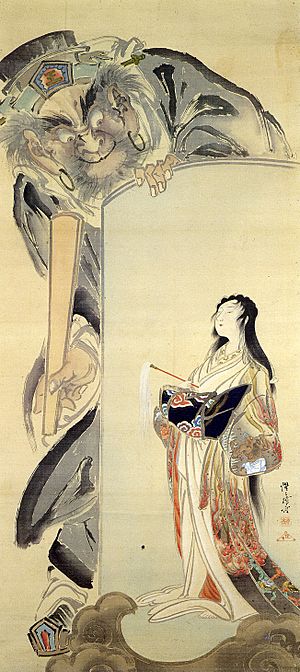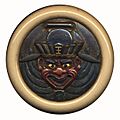Enma facts for kids
Enma is a powerful god in the Buddhist religion. He is often called Yama. Enma is known as the god who decides if people's souls go to heaven or hell after they die.
Contents
Who is Enma?
Enma is the god of the underworld who judges people after they die. He decides if they were good or bad during their lives. The name Enma comes from the word Yama. This word is from Sanskrit and Pali, which are old languages used in Buddhist writings.
Long ago, people believed Enma was the first human to die. He then became the king of a paradise for the dead. Over time, his role changed. He became a god who ruled the dead and decided their fate. In some stories, he is also linked to Jizo Bosatsu, a god of help in Japanese Buddhism. This means he can move between heaven and hell freely.
What Enma Looks Like
Enma usually has a scary look. He is often shown wearing traditional Chinese clothes from the Sung era (around AD 960–1279). It's not fully known why he wears these clothes.
Often, his clothes and face are red. He wears a square crown on his head. In his right hand, he holds a mace, which is like a heavy club. His eyes are wide open, look angry, and slant upwards.
However, Enma's appearance can be different in other countries or in older pictures. For example, in ancient Indian art, Enma might have a crown and ride a water buffalo. He might carry a club and a big rope. Some old Indian pictures show him with a flag, stepping on a water buffalo with one leg. He is often shown as strong, with thick arms and a large chest.
Enma's Important Job
Enma was the very first person to die in the world. After he died, he went to a paradise called Gokuraku Jyoudo. His first job was to look after the dead in this paradise. People thought he was the god of paradise.
But over time, people started to fear Enma. His job changed from caring for the dead to judging them. He would use a club and a big rope to gather the souls of dead people. He ruled the lower world and decided where each person would go. He judged them based on what they did when they were alive. People who lived good lives went to heaven. Those who behaved badly went to hell.
Stories About Enma
There are many interesting stories about Enma. One of the most famous stories is about how Enma will pull out someone’s tongue if they tell lies or do bad things. Japanese parents often use this story to teach their children to be honest.
Enma can also bring dead people back to life. For example, Abe-no-seimei, a famous person from Japanese history, died and was brought back to life by Enma. Enma can even decide when someone's life should end.
There is a strange story about an actor who died and met Enma. The actor was sent to hell because playing other people was seen as "lying." The actor told Enma all about his life and acting. Enma became very interested and said, "I want to see you act!" The actor agreed but said, "I need a costume, so please give me yours." Enma gave him his clothes. The actor then pretended to be Enma, shouting, "Ogres! Ogres! Take this bad man away!" The real Enma was taken away and punished. The actor then became the new Enma!
Enma in Books and Movies
Enma appears in many books and movies, especially in Japan. Many Japanese writers have written about him.
- In The First Love of Enma, Bungeisya by Hideo Watanabe, Enma is shown escaping from hell and falling in love.
- Other books, like Enma’s sword and The Worship of Enma, show a different side of him. In these stories, Enma is not always scary or strong.
- In popular comic books like Dragon Ball, Enma is often shown as kind and calm.
- In the Japanese cartoon Ojarumaru, Enma is even funny.
- Enma also appeared in the American movie Heaven Can Wait (1943). In this film, a dead man talks with Enma about his life. This Enma is strict but not kind. The movie was nominated for best picture.
- Enma has also appeared in One Piece as the name of a powerful sword.
Some writers focus on Enma's power and the fear he causes. Others show his opposite side, making him kind and calm.
Images for kids
-
14th century Chinese Yuan dynasty portrait of King Yama. One of a series of paintings of the "Ten Kings of Hell" by Lu Xinzhong
-
Miyazu, Kyoto Prefecture, Japan. Statue of Yama (Enma) at Nariai-ji
-
Yama, Met Museum
-
19th century kagamibuta netsuke depicting Enma
See also
 In Spanish: Enma para niños
In Spanish: Enma para niños







